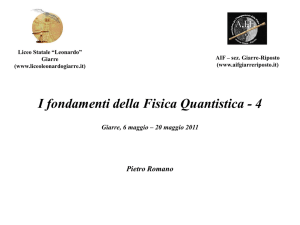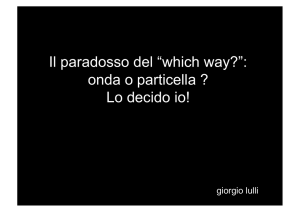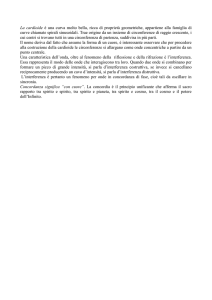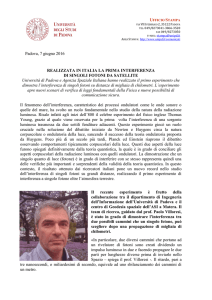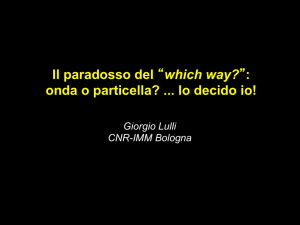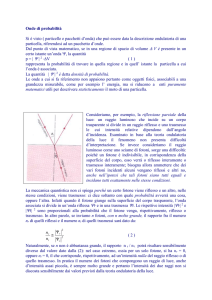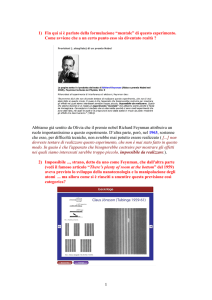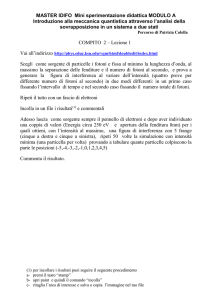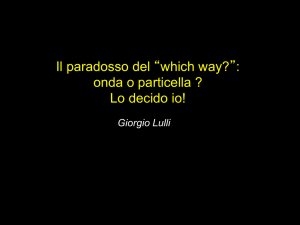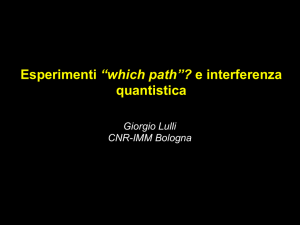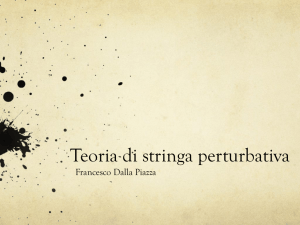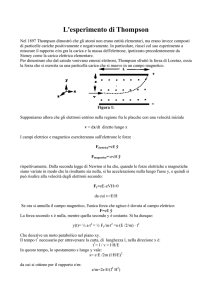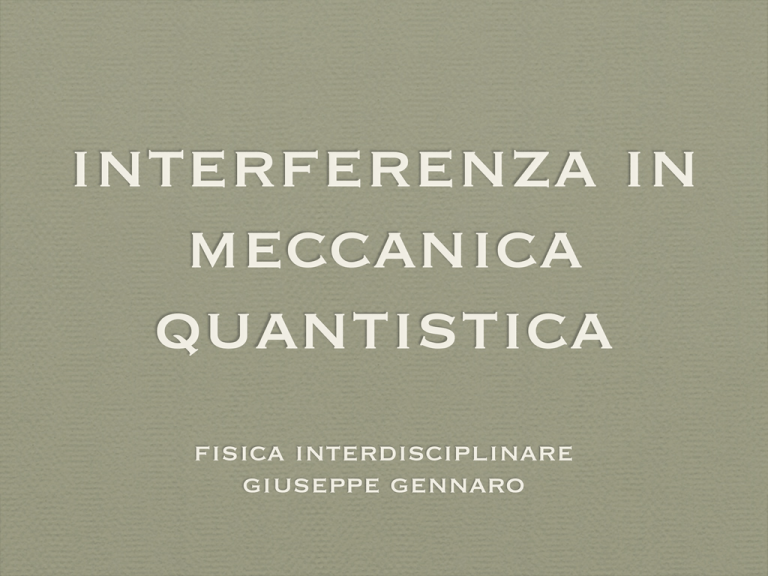
interferenza in
meccanica
quantistica
fisica interdisciplinare
giuseppe gennaro
Il Problema
• La meccanica quantistica descrive con successo i
più disparati fenomeni in natura, dalle particelle
elementari alla nascita dell’universo
• Il problema è che essa implica un certo numero di
nozioni e concetti totalmente controintuitivi
• R.P. Feynman “Nessuno capisce realmente la
meccanica quantistica”
Esperimenti sui
Fondamenti della MQ
• Sin dai primi anni MQ suscita dibattiti sui suoi
fondamenti (Bohr-Einstein, Heisenberg)
• Molti esperimenti, in questi ultimi anni, ha di fatto
confermato la peculiarità controintuitiva della
meccanica quantistica
• Applicazioni sperimentali dei fenomeni
fondamentali: Crittografia quantistica
• Quantum Teleportation and Computation
Esperimento con
proiettili
Apparato Sperimentale
• Mitragliatrice
• Parete con due fessure
• Rilevatore di proiettili
Esperimento con
proiettili
• Chiudiamo la fessura 2
• Otteniamo P1
Esperimento con
proiettili
• Chiudiamo la fessura 1
• Otteniamo la curva P2
Esperimento con
proiettili
• Apriamo le due fessure
• Otteniamo la curva P12
• Verifichiamo che P12 = P1 + P2
• I proiettili arrivano sempre in blocchi
• “No Interferenza”
Esperimento con onde
d’acqua
Apparato sperimentale
• Sorgente d’onde circolari
• Parete con due fessure
• Rilevatore di intensità
Esperimento con onde
d’acqua
• Chiudiamo la fessura 1
• Onda primaria diffratta
• Intensità onda fessura 1
I1
Esperimento con onde
d’acqua
• Chiudiamo fessura 2
• Onda primaria diffratta
• Intensità onda fessura 2
I2
Esperimento con onde
d’acqua: Risultati
• Misuriamo Intensità I12
I12 != I1 + I2
• No granularità
• Le due onde interferiscono
Interferenza
costruttiva e
distruttiva
• Interferenza distruttiva
• ddc= (2n + 1)λ/2
• Interferenza costruttiva
• ddc= nλ
Matematica della
interferenza
• Altezza istantanea dell’onda al detector!
"
iωt
iωt
h
e
h
e
proveniente dalla fessura 1 (2)
1
2
• Altezza istantanea quando le due fessure sono
iωt
iωt
aperte
h1 e + h 2 e
• Intensità dell’onda
I12 = | (h1 + h2 ) | = |h1 | + |h2 | + 2|h1 ||h1 |cosδ
2
•
I12 = I1 + I2 + 2
2
!
2
I1 I2 cosδ
Esperimento con
Elettroni
Apparato Sperimentale
• Elettroni emessi da valvola termoionica
• Accelerati verso la parete
• Parete di metallo con due fessure
• Rilevatore (electron multiplier)
Esperimento con
elettroni: Risultati
P12
• Gli elettroni arrivano sempre in granuli identici tra
loro
•
P12 != P1 + P2
Gli elettroni interferiscono!
Esperimento con
elettroni: Risultati
P1
P12
• Gli elettroni arrivano sempre in granuli identici tra
loro
•
P12 != P1 + P2
Gli elettroni interferiscono!
Esperimento con
elettroni: Risultati
P1
P2
P12
• Gli elettroni arrivano sempre in granuli identici tra
loro
•
P12 != P1 + P2
Gli elettroni interferiscono!
Esperimento doppia
fenditura: elettroni
Interpretazione
• Gli elettroni arrivano in granuli, come particelle
• La probabilità di arrivo di questi granuli è distribuita
come la distribuzione della intensità di una onda
• Un elettrone si comporta talvolta come una
particella talvolta come una onda
• E’ non vero che gli elettroni o passano dalla fessura 1
o dalla fessura 2
Osserviamo gli
elettroni
• Quando osserviamo da dove passano gli elettroni
distruggiamo la figura di interferenza
P12 = P1 + P2
• Aumentando la lunghezza d’onda della luce non
sappiamo più da dove passano gli elettroni e
riotteniamo la figura di interferenza
P12 != P1 + P2
Riassunto dei nostri
esperimenti
• La probabilità di un evento è data dal quadrato di
una quantità complessa φ chiamata ampiezza di
2
probabilità
P = |φ|
• Se un evento può accadere in diversi modi
alternativi la ampiezza di probabilità per l’evento è
P = |φ1 + φ2 |2
• Se è possibile determinare a priori se una o l’altra
alternativa è scelta realmente
P12 = P1 + P2
Interferenza
quantistica: Criterio
• Se è impossibile distinguere fra differenti percorsi
alternativi dalla sorgente al detector, le ampiezze di
probabilità si addizioneranno coerentemente.
• L’assenza di ogni informazione sul reale percorso è il
criterio essenziale perchè si manifesti la interferenza
quantistica
• Se tale informazione è accessibile dall’esperimento
si distrugge la figura di interferenza
Principio di
Indeterminazione
• “E’ impossibile progettare un apparato per
determinare da quale fessura passa l’elettrone che
allo stesso tempo non disturbi l’elettrone
abbastanza da distruggere le frange di
interferenza” (Heisenberg)
∆x∆p ≥ !
Entanglement
• Lo stato del sistema elettrone-fotone scatterato è
uno stato “entangled”
1
|ψ! = √ (|e, 1!|f, 1! + |e, 2!|f, 2!)
2
• Se i due stati per il fotone sono ortogonali non
appare nessuna figura di interferenza
• Se la misura sul fotone non è capace di dire da
quale fessura l’elettrone è passato, interferenza!
Interferenza getta
luce sulla natura
• Possiamo osservare caratteristiche ondose
(interferenza) o particellare (seguendo il path che la
particella sceglie) a seconda dell’esperimento che
scegliamo
• Interpretazione errata: si propagano onde e si
rilevano particelle
• Interferenza a due particelle sconfessa questa
interpretazione
Interferenza a due
particelle
• Una particella decade in due e colpisce uno
schermo secondo due path differenti: particella 1 o
in fascio a o a’ e particella 2 o in b o in b’
1
|ψ! = √ (|a!1 |b!2 + |a! !1 |b! !2 )
2
Interferenza a due
particelle
• Non osserviamo fenomeni di interferenza per la
particella 1
• Anche in principio possiamo porre detectors nei
fasci b e b’ e quindi conoscere indirettamente che
percorso ha fatto la particella 1
• Formalmente non possiamo sovrapporre le
!
ampiezze (coerentemente)|a!1 e |a !1 perchè
entangled con |b!2 e |b! !2
Interferenza a due
particelle
• Una particella decade in due che colpiscono due
schermi secondo due path differenti
Entanglement
• Se la particella originaria è ferma, le due particelle
figlie avranno momenti approssimativamente
uguali e opposti
• Le particelle possono passare o dalle fessure A e A’
o da B e B’
• Lo stato delle due particelle
1
|ψ! = √ (|a!1 |a! !2 + |b!1 |b! !2 )
2
Interferenza a due
particelle
• Se la posizione della particella che decade è incerta
molto più di λ/θ non si osservano frange di
interferenza sui singoli schermi
• Ma se si monitorano le posizioni di arrivo in
coincidenza, le due particelle è più probabile che
atterrino dove i percorsi alternativi PAOA’P’ e
PBOB’P’ differiscono per un multiplo intero di
lunghezze d’onda
Due interferenze
mutuamente esclusive
• Se d >> λ/θ , δk/k << θ e quindi non capace di
illuminare le due fessure contemporaneamente,
così non ci può essere interferenza di singola
particella
• Se l’indeterminazione è piccola, le due fessure
possono essere illuminate e creare interferenza nei
singoli schermi, ma non si può più dire che se il
fotone passa da A, l’altro passerà da A’. Questo
fatto distrugge lo stato entangled di due particelle
Distinguibilità dei
Paths (Zou et al. 1991)
√
1/ 2 (|d"1 |e"2 + |h"1 |k"2 )
√
1/ 2 (|d" + |h")1 |k"2
The quantum eraser
effect, enhance or suppress the atomic emission
process in the crystal by
small movements of mirrors that are several feet
away!
Figure 5 shows an experimental arrangement first
used by Alley and Shih,6
and recently exploited by
Paul Kwiat and coworkers
at Berkeley17 to demonstrate Marian Scully's notion of a "quantum eraser."
Manipulating one photon can
alter the interference pattern
of another. The arrangement16
sketched in a can produce an
interference pattern at
detector D, when the phase
shifter P is varied. An
entering ultraviolet photon a
is split at beam splitter A so
that both down-conversion
crystals (X, and X,) are
illuminated. One of the
resulting pair of downconversion photons can reach
D, by way of beam path d or
h. If one could monitor
beams e and k separately, one
would know in which crystal
the down-conversion
occurred, and there would be
no interference. But merging
beams e and k in this
configuration lets the
alternative paths of the other
photon interfere. A new variant
of this scheme, shown in b,
uses only one crystal (at the
center). The ambiguity here
is created by reflecting the
originating beam (blue, from
the top of the photo) and its
down-converted progeny (red
and green) back through the
crystal from mirrors (at the
bottom of the photo), so one
can't know on which pass the
down-conversion
occurred. Figure 4
will now be no superposition
of the two amplitudes, and
Esperimento di Zou
• Il secondo fotone non è necessario che sia rilevato
• Se il fascio e è bloccato le frange in D1
scompariranno perchè adesso è possibile
(potenzialmente) rilevando un fotone in k ci
potrebbe dire che è stato creato in X2
• i fasci e e k non sono nei paths alternativi che
portano A a D
conversion photons can reach
D, by way of beam path d or
h. If one could monitor
beams e and k separately, one
would know in which crystal
the down-conversion
occurred, and there would be
no interference. But merging
beams e and k in this
configuration lets the
alternative paths of the other
photon interfere. A new variant
of this scheme, shown in b,
uses only one crystal (at the
center). The ambiguity here
is created by reflecting the
originating beam (blue, from
the top of the photo) and its
down-converted progeny (red
and green) back through the
crystal from mirrors (at the
bottom of the photo), so one
can't know on which pass the
down-conversion
occurred. Figure 4
Herzog et al. (1993)
effect, enhance or suppress the atomic emission
process in the crystal by
small movements of mirrors that are several feet
away!
The quantum eraser
Figure 5 shows an experimental arrangement first
used by Alley and Shih,6
and recently exploited by
Paul Kwiat and coworkers
at Berkeley17 to demonstrate Marian Scully's notion of a "quantum eraser."
Others have called it
"haunted" or "phantom"
measurement.18 To appreciate the basic idea,
first suppose that only the
beam splitter is in the path
of the two beams emerging
from the down-converter
crystal. This arrangement
produces an interesting
and very basic two-particle
effect: Both particles must end up in the same detector.19
The reason is simple. To get coincident counts at the
two detectors, either particle 1 (the photon that ultimately
lands in detector 1) takes route a and particle 2 takes route
will now be no superposition
of the two amplitudes, and
therefore coincidence counts
between the two detectors
will be observed.
But it is still possible to
"erase" this path information
and recover the interference
by placing a linear polarizer
in each beam, as shown in
the figure. If both polarizers
are either horizontal or vertical there will be path information present. But if they are oriented at 45° to the
horizontal, either route, a or b, can now lead to either
detector. The coherence is restored and there are, once
again, no coincident counts.
Quantum Eraser
three-particle d
(Alternatively o
three-particle do
sume for simplic
cay particles all
and the same en
of course, come
decay plane. A
screens with ho
two possible sta
The coherent su
Polarizers can serve as quantum erasers.17 A single ultraviolet
photon entering a down-conversion crystal (gray) produces two
optical photons that mix at a beam splitter (dashed blue line) before
arriving at detectors D, and D2. If there are no polarizers (P) or
polarization rotator (R) in the beams, both photons must end up in
the same detector. Inserting a 90° rotator into beam b provides
information that renders the beams incoherent and thus produces
coincidence counts in the two detectors. Inserting the polarizers
oriented 45° to the horizontal after the beam splitter erases that
The beams a', b
the phase shifter
(3 and y, after
beams are recom
ters A, B and C
splitters are the
ers. One record
multaneous coun
and K or K'. If
-1) to a count
primed) counter,
.................................................................
.................................................................
energies. Our good quantitative agreement between experiment and blac
are then accelerated and directed towards a conversion electrode. The
theory indicates that
lattertodobenot
influence
observed
surec
wasthe
found
smaller
than1the
1mm
mm
height,
found
to be smaller
than
ininheight,
co
are subsequently counted by a Channeltron electron multiplier. Thecoherence. All thesewas
observations
support
the
view
that
each
C
a
typ
60 powe
Rayleighlength
lengthofof800
800!m
!mand
andthe
thestrong
strong
Rayleigh
power
time
molecule interferes with
itself only.
reproducibly scanned transversely to the beam with 1-!m resolution.
ionization
process. A significant advantage
Counts in 50 s
ionization process. A significant advantage
corro
mechanismisisthat
thatititdoes
doesnot
notdetect
detectany
anylof!
o
mechanism
presentininthe
thevacuum
vacuumchamber.
chamber.We
Wecould
couldthus
thus
present
influa
of less
less than
thanone
oneper
persecond
secondeven
evenunder
und
mol
arates of
1,200 rates
Markus
Arndt,
Olaf
Nairz,
Julian
Vos-Andreae,
Claudia
Keller,
#
7
Markus Arndt, Olaf Nairz, Julian Vos-Andreae, Claudia Keller,
mbar).The
The
f
vacuum conditions
conditions (5(5""1010# 7 mbar).
100
fu
vacuum
Gerbrand
van
der
Zouw
&
Anton
Zeilinger
Gerbrand van der Zouw & Anton Zeilinger
be n
1,000
thenfocused
focusedbybyan
anoptimized
optimizedion
ionlens
lenssystem,
system
then
A
a BeCu
BeCu conversion
conversionelectrode
electrodeatat!9!9kV
kVwhere
wher
a
NATURE
VOL 401 | 14 OCTOBER
1999
| www.nature.com
Institut
Experimentalphysik,
Universität
Wien,
Boltzmanngasse5,5,
pho
800
Institut für
für|Experimentalphysik,
Universität
Wien,
Boltzmanngasse
emission ofof electrons
electronswhich
whichwere
weresubsequent
subsequen
emission
A-1090
Austria
indu
A-1090 Wien,
Wien, Austria
Channeltron
detector.
inte
600 Channeltron detector.
..................................
.........................
.........................
.........................
.........................
........
Alignment
is
a
crucial
part
of
this
experimen
.................................. ......................... ......................... ......................... ......................... ........
Alignment is a crucial part of this experiment.
inte
Quantum superposition lies
lies at
at the
the heart
heart of
of quantum
quantummechanics
mechanics
tofind
findthe
thebeam
beamininthe
thefirst
firstplace,
place,our
ourcollima
collim
A
400 to
and gives rise to many of
of its
its paradoxes.
paradoxes. Superposition
Superposition of
of de
de movable
movablepiezo
piezoslits
slitsthat
thatcan
canbebeopened
openedfrom
from0in0toat
fero
200 of
has been
been observed
observed for
for massive
massive particles
particles
Broglie matter waves11 has
ofthe
thefirst
firstslit)
slit)and
andfrom
from0 0toto200
200!m
!m(for
(for
t
the
b
200 vacuum
vacuumchamber
chamberisisrigidly
rigidlymounted
mountedononananbe
oa
atoms and
and dimers
dimers33,, small
small van
van der
der Waals
Waals
such as electrons22, atoms
opt
up t
clusters44, and neutrons55.. But
But matter
matter wave
wave interferometry
interferometry with
with with
withthe
theionizing
ionizinglaser,
laser,ininorder
ordertotominimize
minimize
sp
spa
muc
Theeffect
effectofofgravity
gravityalso
alsohad
hadtotobebeconsidered
considere
larger objects has remained
remained experimentally
experimentally challenging,
challenging, despite
despite
150
The
case
!1
!1
the development of powerful
powerful atom
atom interferometric
interferometrictechniques
techniquesfor
for the
themost
mostprobable
probablevelocity
velocity(220
(220mms s ),),the
thefullere
fulle
thro
whiletraversing
traversingthe
theapparatus.
apparatus.This
Thisimposes
imposes
experiments in fundamental
fundamental quantum
quantum mechanics,
mechanics,metrology
metrologyand
and
shou
a
100 while
6
report the
the observation
observation of
of de
de Broglie
Brogliewave
wave maximum
lithography . Here we report
maximumtilt
tiltthat
thatthe
thegrating
gratingmay
mayhave
havewith
withcont
re
resp
typicaldiffraction
diffractionangle
angleinto
intothe
thefirst-order
first-orderinte
m
molecules by
by diffraction
diffraction at
ataamaterial
materialabsorpabsorp-50 typical
interference of C60 molecules
ma
envi
tion grating. This molecule
molecule is
is the
the most
most massive
massive and
and complex
complex one
onecan
cantolerate
tolerateaatilt
tiltangle
angleofof(at
(atmost)
most)about
abo
the
moleculesstart
startfalling
fallingfrom
fromone
onediffraction
diffractionorder
ord
object in which wave behaviour
behaviour has
has been
been observed.
observed.Of
Ofparticular
particular0 molecules
gase
is
almost
a
classical
body,
because
of
its
–100
–50
0
50
100
of
a
neighbouring
order
of
a
different
ve
is
almost
a
classical
body,
because
of
its
interest is the fact that C60
of
a
neighbouring
order
of
a
different
60
A
Position
(µm)
experimentalcurves
curvesstart
starttotobecome
becomeasymmet
asymme
many excited internal degrees
degrees of
of freedom
freedom and
and their
their possible
possible experimental
exam
couplings to the environment.
essential
for
grating
tilt
more
500
f
whic
environment. Such
Such couplings
couplings are
areFigure
essential
for pattern
2 Interference
produced
by Cdeviates
molecules.by
a,
recording
grating
tilt
deviates
byExperimental
morethan
than
500!rad
!rad
60
7,8
who
circles) and fit usingvertical
Kirchhoff diffraction
theory (continuous line). The expected
orientation.
,, suggesting
interference
vertical
orientation.
suggesting that
that(open
interference
the appearance of decoherence
decoherence7,8
stud
zeroth and
first-order maximaThe
can beinterference
clearly seen. Details
of the theory
discussed
inclearly
experiments with large
detailed
pattern
ofofare
Fig.
2a2aclearly
e
large molecules
molecules should
should facilitate
facilitate
detailed
The
interference
pattern
Fig.
the text. b, The molecularmaximum
beam profile without
the the
gratingfirst-order
the path of thediffraction
molecules.
pep
maximum and
and
the infirst-order
diffractionand
studies of this process.
When considering de Broglie
develop
Broglie wave
wave phenomena
phenomena of
of larger
larger and
and between
betweenzeroth
zerothand
andfirst
firstorders
orders
arewell
well
develo
©are
1999
Macmillan
M
NATURE | VOL 401 | 14 OCTOBER 1999 | www.nature.com
more complex objects than
destructiveinterference
interferenceofofCC
than atoms,
atoms, fullerenes
fullerenes come
come to
to mind
mind asas destructive
deBroglie
Brogliewave
wav
6060de
99
suitable candidates. After
After their
their discovery
discovery and
and the
the subsequent
subsequent neighbouring
neighbouringslits
slitsofofthe
thegrating.
grating.For
Forcomparison
compariso
10
invention of efficient mass-production
mass-production methods
methods10,, they
they became
became the
the profile
profile ofof the
the undiffracted
undiffractedcollimated
collimatedbeb
Counts in 1 s
es Ltd
Wave–particle
duality
Wave–particle duality
of C60
molecules
60
#1
tures between 900 and
v0 ¼ 166
vm ¼ 92
s #601 as
expected via
for heating
a transition
absorbed
lightm sthenand
ionized
them C
fullerenes
and
13
passed through two
betweenthermal
a maxwellian
effusive
and12a. supersonic
beam region
. The
subsequent
emission
of beam
electrons
The
detection
eparated by a distance most probable velocity was v ¼ 220 m s # 1 , corresponding to a de
g nanofabricated SiNx Broglie wavelength of 2.5 pm. The full-width at half-maximum was
de slits with a 100-nm as broad as 60%, resulting in a longitudinal coherence length of
about 5 pm.
100 nm diffraction
Scanning photodiffraction grating, the
The essential features of the
interference
pattern
can be undergrating
ionization
stage
atially resolving detec- stood using standard Kirchhoff diffraction theory14 for a grating
gon-ion laser (24 W all with a period of 100 nm, by taking into account both the finite
Oven
width (this is the size width
of the collimation and the experimentally determined velocof that in the centre of ity distribution. The parameters in the fit were the width of the
tically, parallel both to collimation, the gap width s0 of a single slit opening, the effective
he collimation slits. By beam width of the detection laser and an overall scaling factor. This
Ion
could be scanned with model, assuming all grating slits to be perfectdetection
and identical,
10 µm
10 µm
erence pattern. The reproduces very well the central peak of the interference
pattern
unit
enes via heating and shown in Collimation
Fig. 2a, butslits
does not fit the ‘wings’ of this pattern.
Agreement with the experimental data, including the ‘wings’ in
The detection region
shown in Fig.
Agreement w
Figure 1 Diagram
leave the oven thro
(width " height "
(width " height) se
the second slit, and
grating. The ions ar
ejected electrons a
laser focus can be
Laser
nning photozation stage
Ion
detection
unit
680
© 1999 Macmillan Magazines
Figure 1 Diagram of the experimental set-up (not to scale). Hot, neutral C60 molecules
leave the oven through a nozzle of 0:33 mm " 1:3 mm " 0:25 mm
(width " height " depth), pass through two collimating slits of 0:01 mm " 5 mm
(width " height) separated by 1.04 m, traverse a SiNx grating (period 100 nm) 0.1 m after
the second slit, and are detected via thermal ionization by a laser 1.25 m behind the
grating. The ions are then accelerated and directed towards a conversion electrode. The
ejected electrons are subsequently counted by a Channeltron electron multiplier. The
laser focus can be reproducibly scanned transversely to the beam with 1-!m resolution.
RIsultati esperimento
• Il pattern di interferenza dovuto a singola molecola
• Non esiste alcuna interferenza tra due molecole
durante la loro evoluzione nell’apparato
• Molecole possono emettere radiazione (eccitati
termicamente)
• Se lo sperimentatore individua la molecola
emettente il fotone no figura di interferenza
Perchè otteniamo
sempre interferenza
h
• Lunghezza d’onda associata λ =
p
• Se lunghezza d’onda fotone più piccola del doppio
della distanza tra due fessure possiamo localizzare
la molecola e conoscerne il path
• Lunghezza d’onda fotone 100 volte più grande
• Stato fotone e stato molecola non entangled
perchè gli stati fotone non sono ortogonali

